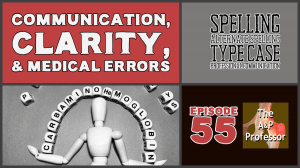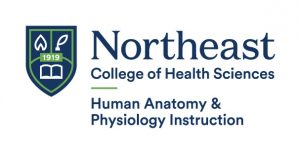Revisiting A&P Learning Outcomes
TAPP Radio Ep. 54 TRANSCRIPT
The A&P Professor podcast (TAPP radio) episodes are made for listening, not reading. This transcript is provided for your convenience, but hey, it’s just not possible to capture the emphasis and dramatic delivery of the audio version. Or the cool theme music. Or laughs and snorts. And because it’s generated by a combo of machine and human transcription, it may not be exactly right. So I strongly recommend listening by clicking the audio player provided.
 This searchable transcript is supported by the
This searchable transcript is supported by the
American Association for Anatomy.
I’m a member—maybe you should be one, too!

Episode 55 Transcript
Communication, Clarity, & Medical Errors
Kevin Patton: The author, Marilyn Vos Savant once stated, “When our spelling is perfect, it’s invisible. But when it’s flawed, it prompts strong negative associations.”
Aileen: Welcome to The A&P Professor. A few minutes to focus on teaching human anatomy & physiology with a veteran educator and teaching mentor, your host, Kevin Patton.
Kevin Patton: In this episode I discuss correct spelling and alternate spelling, the proper use of letter case and the place of professional communication in our course.
Kevin Patton: I’ve been teaching A&P a long time, over 30 years, and you know what? I’m a different teacher now than I was in the early days, different in many ways. One of the things that’s changed is my approach to spelling. Should I require correct spelling on tests and quizzes? That is, if it’s not spelled correctly, is it fully incorrect or should I give some credit for getting close and full credit only if it’s spelled correctly? Well, in my early days of teaching A&P, I thought it was okay for students to misspell their answers. Not ideal, but okay. So I deducted points for misspelling, but gave them at least partial credit if I thought they were thinking of the right answer. In fact, I often tried to avoid the possibility of misspelling by giving them word banks to refer to or giving them multiple choices for items that would likely misspell.
Kevin Patton: Well, you know what, now I’m all the way at the other end of the spectrum. I give a lot more items where they have to spell things out with no additional help from me, and if it’s not spelled exactly correctly, it’s just not the correct term, period. Zero credit for misspelled terms. Why this change in approach? Well, in a word, medical errors. Okay, wait, that’s two words, isn’t it? Okay. Sorry about that. But my point is, is that correct spelling is linked to medical accuracy and I don’t think I’m doing my job fully if I’m not teaching spelling along with everything else in my course.
Kevin Patton: About 10 years ago, I reported in the A&P Professor Blog that I’d read another blog post from Scientific American. The title of it was Deaths From Avoidable Medical Error, More than Double in the Past Decade an Investigation Shows. Now that post from 10 years ago talked an investigation that had found that preventable medical mistakes, including infections, caused about 200,000 deaths in the United States each year. About double the number 10 years before. And then a few weeks ago, I saw another report, a very thorough report by the way. They found that about 6% of patients in the United States are impacted by preventable medical errors. That’s about one in 20 patients. A statistic that I’m sure will pop into my head the next time I’m sitting in a medical waiting room, which I do a lot of, by the way, being the driver and interpreter, big medical words for my 87-year-old mother, as I’ve mentioned in previous episodes of this podcast, I sometimes have a recurring dream that you probably have too, that I’m waking from an unconscious state in an emergency room somewhere. And one of my former students is smiling down at me and says, “Don’t worry Kevin, I’ll be taking care of you.” And it’s someone who failed my class because they couldn’t tell a femur from a fibula. Usually in those dreams I wake up screaming.
Kevin Patton: So I have a personal stake in preventing medical errors, not just for me and my elderly mom, but I have a stake in, well, everyone I know being exposed to medical errors and everyone I don’t know, but nonetheless may acquire an infection from, or to whom I might contribute a share of the medical costs through insurance premiums and taxes. My belief that we’re all socially and emotionally and spiritually connected to each other, along with my personal commitment to live a compassionate life reinforces my personal stake in preventing medical errors. And being an educator, I know that one of the many strategies that together can reduce medical errors is solid thorough training.
Kevin Patton: So I often remind myself that this is why I’m as hard nosed as I am about to spelling it correctly, because some day there’ll be posting things to our medical records and they’d better not be typing in perineum when they mean peritoneum. So yeah, the topic of correct spelling and the consequences of incorrectly spellings is important in teaching and learning human anatomy and physiology. This course is a critical foundation for many health professions. Professions where misspellings can be the basis for life threatening medical errors. There are even some terms that were once common in medicine, mostly abbreviations and acronyms that are now banned in hospitals because they were so close in spelling and appearance to other terms, that they caused a lot of medical errors. In fact, there’s an official do not use list. On that list, there’s things like using U for unit or IU for International Unit. These are banned because they can be easily misread or confused with similar terms
Kevin Patton: So here’s what I tell my own students about spelling. That’s part of learning how to communicate accurately and professionally. For those of you going into patient care or managing patient records, accuracy can affect a person’s life. So it’s best to learn that lesson here and now where no one’s life is in danger. I put that in my course documents and I tell them there really is a difference between perineum and peritoneum. Just two letters and the whole meaning of the sentence or paragraph or medical record is changed. It may still make sense even in context, but it’s now wrong. It’s the wrong sense. An infection or injury of the perineum is quite different than an infection or injury of the peritoneum.
Kevin Patton: Some of my students counter that, current software platforms used in hospitals and clinics have safety features that auto correct or call attention to potential errors.and well yeah, that’s true to some extent, but just like the auto-correct features found in word processing software, you don’t want to rely on them entirely. We really must know which term is which by its correct spelling and not rely on the built in safety mechanisms.
Kevin Patton: By the way, I think one of the benefits of using online testing as a form of retrieval practice, the strategy I’ve mentioned a lot in previous episodes is that the computer will not accept a fill in or short answer unless it’s typed exactly as expected. Some systems won’t even accept an extra space at the beginning or end of whatever the student has typed in or it won’t accept it if the capitalization is incorrect, that’s usually a little checkbox in there in the learning management system, whether you want to accept any capitalization. And unless you type them in as alternate answers, these systems won’t accept the plural form either when the singular form is what will accurately answer or complete the wording for the test item.
Kevin Patton: Because I give my students multiple attempts at online tests, they have another chance. And I found that they all quickly get the hang of it, but that’s only if I mark it wrong and don’t accept it the first time, then on their second or third attempt, now they’re actually paying attention to the spelling and the pluralization and so on. And they do it. All of them do it. It’s kind of amazing even to me how easily they can adapt to that once you force them into it. And when I say all of my students get the hang of it, I also include those who legitimately struggle with spelling, not because they’re lazy or stupid, but because they have specific challenges that make it harder for them to spell correctly. Then it is for me to spell things correctly. Things like dyslexia or language difficulties or tremors that make typing difficult. But you know what? There are usually ways to compensate for, overcome those challenges and I’m willing to help my students do that. It’s just going to take some extra time and effort, but it can be done. And you know what, they do.
Kevin Patton: When I’m thinking about how we are preparing our students for their profession, I want my healthcare providers to get it right, so hey, let’s make that happen.
Kevin Patton: This podcast is sponsored by HAPS, the Human Anatomy & Physiology Society, promoting excellence in the teaching of Human Anatomy & Physiology for over 30 years. I’ve been a member that whole time and I still get great value from my membership. Go visit HAPS at theAPprofessor.org/haps, that’s H-A-P-S.
Kevin Patton: Yeah, yeah, I know. A lot of terms we use in A&P have alternate spellings, that is there are correct spellings that differ from other cracks spellings. I know that. Because I require correct spellings and I’m not always aware of other alternative spellings that are also correct, then I have to be nimble and humble. If I score a test or quiz item wrong because of misspelling, and a student comes back with evidence that their spelling is correct, then I have to be willing to accept that gracefully. In fact, I encourage my students to challenge their test scoring for this and any other legitimate reason they have. Because in doing so, it builds confidence in their own judgment and reasoning and it also shows them that although questioning is encouraged in any discipline or profession, we also need to realize that sometimes we’re mistaken. So sometimes it’s the student who is mistaken when challenging my test item and sometimes it’s me that’s mistaken when creating or scoring that test item, either way, it’s a learning opportunity for one or both of us.
Kevin Patton: Now, way back in episode 17, I mentioned the acceptable alternate spellings of the term mammillary, as in the mammillary bodies of the hypothalamus. And I also explained why I use the spelling that I prefer. In a case like mammillary, then I’m happy to accept either spelling as long as that student uses it consistently and doesn’t switch back and forth. But some alternate spellings, I’m less willing to accept. For example, I specify in my course documents that we use American English in our course. Now, I can and do make exceptions for individual students who generally communicate in some other dialect of English besides US English, but they have to request it. Usually they don’t.
Kevin Patton: If they do request that, then I don’t accept them switching back and forth between US and UK spelling. They have to pick one and stick with it because I think they learned something by adapting to a particular system and sticking with that system. In this case it’s a language, a dialect of a language.
Kevin Patton: Now, I have a few links in the show notes and the episode page for this episode @theAPprofessor.org that help with understanding dialect based differences in spelling. For example, the color gray is normally spelled with an a in American English, but it’s spelled with an E outside the United States. This is a common word that students are inconsistent with, so I make a big effort to clarify that for them at the beginning. So when gray matter is an answer for a test, I’m likely to get gray with an A because I’ve talked about it and not grey with an E, at least not from my American students because again, we’ve talked about that.
Kevin Patton: So yeah, there are alternative spellings and sometimes I have to do some extra work to determine whether a misspelling is actually just another acceptable spelling. So yeah, that complicates my efforts to teach my students proper spelling for clear and accurate communication that reduces errors and misconceptions, but I can handle it. Yes, I can.
Kevin Patton: A searchable transcript and a caption audio audiogram of this episode are funded by AAA, the American Association for Anatomy. Check out their new logo @anatomy.org and while you’re there, check out their membership benefits too.
Kevin Patton: While we’re on the topic of spelling, which is an essential part of professional scientific communication, I want to talk about the proper use of letter cases, that is capitalization. I mention this because it’s a matter of accurate communication. Not only accurate communication among health professionals but also accurate non confusing communication between me and my students. And the reason it’s worth mentioning beyond just that general idea of clarity, is that I see the confusing misuse of case formatting a lot among A&P teachers. I think the reason is that most of us really haven’t been taught the ins and outs of using capitalization properly in scientific communication. I think maybe there’s an unstated expectation that we’ll all learn it by osmosis or some other passive mechanism and clearly that has not worked. Not entirely.
Kevin Patton: I realize that I’m coming at this from a slightly different angle than most A&P faculty. As a textbook author, I’ve had several decades of constant training and retraining from professional copy editors. And I’ve learned a lot of things about using written language that I never learned in school. So when I talk about these things, I’m kind of channeling these women and men whose entire careers are spent making sure that scientific journal articles, reference books and tax books communicate ideas accurately and clearly.
Kevin Patton: So what’s the issue? Well, it turns out there are several issues, but let’s start with a quick rundown of definitions. Upper case letters refer to the larger letters in a type font that has two parallel sets of letters, one set with big letters and one set with small letters. Upper case letters are also called capital letters. The smaller letters are called lower case letters as I explained in the Word Dissection segment of preview episode 55 that introduced this full episode 55.
Kevin Patton: We all know that in today’s usage, using all upper case letters is okay for headings, for stop signs, for labeling things like drafting diagrams. But in most other circumstances using all capitals is read as a written form of shouting. So when we use all caps for emphasis, our students and colleagues may read it as shouting. It’s not exactly wrong to use all caps for emphasis, but I may send a different message than I intend when I mean to emphasize and do not mean to shout. Italic or slanted font is a better way to convey emphasis without it being mistaken is shouting. Underlining can also work. Even bold face or heavy font may work for emphasis.
Kevin Patton: But what if you’re typing in a platform where you can’t easily use italic or bold or underline? Well then using an asterisk before or after the term may emphasize it without seeming to be shouting. I’m getting pretty far into the weeds here, I know. I bring up the all caps thing because I sometimes see this in a course syllabus or I see it in directions to a test, where I’m trying to communicate to my students in a supportive way and yes, I’ve occasionally used all caps myself in a syllabus or test instructions. Sometimes that’s done intentionally, but when I do it intentionally, I’m doing it in an ironic or joking way, but I also sometimes catch myself doing it for emphasis. Maybe I was shouting inside my head when I was typing it, but when I find these I change them. I really don’t want to be shouting at my students in my syllabus or during a test, heck, they’re already anxious on the first day of class and on each test day.
Kevin Patton: The only time I really want to shout to my students is if there’s a fire and then it’s not going to be in all caps. It’s going to be actual yelling. Another improper use of case. One that I think can confuse students is inconsistent use of sentence case. Sentence case is how you capitalize letters in a proper sentence.
Kevin Patton: The first letter of the first word is capitalized. We often use sentence case for things other than sentences, for example, when listing choices in a multiple choice test item or in a lab list that we give to our students, which lists all the structures they need to be able to identify in a lab specimen or anatomical model. But I often see test items or lab lists or similar learning documents that switch back and forth, seemingly randomly between all lower case and sentence case. This may seem picky and well maybe it is, but besides the fact that if I want to be respected by my students as a professional, I need to act like a professional. I’m convinced that this back and forth use of sentence case and all lowercase can be confusing to many students. People with very rigid patterns of thinking have an especially hard time with this. They’re often distracted when they try to find a pattern or significance behind the switching of capitalization. It’s just not there, it’s just sloppiness. But some rigid thinkers won’t necessarily see it for that and they’re going to get distracted or confused or both, as they try and figure out the pattern.
Kevin Patton: So I have to watch that and this is why I proofread my syllabus and my tests and my lab lists over and over again. Probably the misuse of capitalization that has the biggest chance of confusing students is the misuse of title case. Title case is when each word in a phrase is capitalized, except for usually articles or prepositions or conjunctions, unless they’re the first word of a phrase. Each major formal style like APA or Chicago Style or MLA, there’s a whole bunch of other ones, they each have their own specific rules about what gets capitalized in title case. But it’s safe to say that it’s all the important words in a phrase.
Kevin Patton: Title case is used for titles, but it’s also used for proper names. Names of particular people, places or things. And this is where the inconsistent use and result in confusion come in, I think. If I’m using the phrase Kevin Patton in a sentence, then it should be in title case, with each word capitalized. Kevin gets capitalized with a capital K, Patton gets capitalized with a capital P because it’s a proper noun, it’s my name and same for anyone’s name. Same for not just people name, but organizations like American Association for Anatomy where American Association and Anatomy are all capitalized, but four is not capitalized.
Kevin Patton: Okay. So far, so good title case starts to get problematic when things that are not proper nouns. You’re not supposed to use title case for common nouns. You’re only supposed to use title case for proper nouns.
Kevin Patton: In science, the conventional style is to use title case only for eponyms or similar proper nouns. So in a test item, when I capitalize the name Langerhans in the phrase islets of Langerhans, that’s okay, as long as I don’t also capitalize the word islets, unless islets is the first word in a sentence or the first word in a number choice in a list of multiple choices when I’d be using sentence case, so whatever happens to be the first word gets capitalizes. It’s not part of the title case.
Kevin Patton: But if I’m using the term central nervous system, none of those words should be capitalized. I would only do that if I’m using it as the title of a section heading, but not in the middle of a sentence such as a test item. And if it’s one of several multiple choices offered for a test item, I’d use sentence case and I’d capitalize the word Central, but not the words nervous or system.
Kevin Patton: Yeah, I know that the acronym for central nervous system is capital C, capital N, capital S, all caps. But just because the acronym is all caps, doesn’t mean the full complete term uses any capitalization. Like oxygen, the symbol for oxygen is a capital O, but we don’t capitalize oxygen unless it’s in a heading or a subheading or the first word in a sentence. At least we shouldn’t be capitalizing oxygen, although I have seen that. If it’s in the middle of a sentence, you do not capitalize oxygen or carbon dioxide. You don’t even capitalize carb amino hemoglobin, even though I think that word needs some kind of distinction as being a wonderful word, but alas, language just doesn’t provide anything for that special honor for carbon amino hemoglobin. If you’re using carbon amino hemoglobin in the middle of a sentence, does not get capitalized.
Kevin Patton: The thing is if I’m capitalizing central nervous system and the name of every organ and structure in the body, like liver and kidney and nephron and maxilla, but nobody else is doing that, most obviously, the text books and online resources that the students are using, unless obviously on the other courses that students are or will be taking, then this inconsistency is going to be confusing. And for many students, the concepts we teach are already generating some confusion, especially when they’re first encountered. There’s already a lot of information keeps stray, without having to cope with inconsistent style of terminology.
Kevin Patton: Yeah, I know. A lot of students are able to easily look past my sloppiness and my inconsistency and my odd formatting. Usually they’re the ones who came in already knowing a lot of this stuff. But the at risk students, those really struggling to learn and to keep up, they’re the ones I’m likely to confuse. They’re the ones facing a set of obstacles that shouldn’t really be there at all if I’m being consistent in my communication. So that’s why I try my best to use conventional, professional style when using terminology in my course. Why I make an extra pass or two or three on all my course documents, to make sure I’m doing things as plainly, consistently and properly as I can.
Kevin Patton: The free distribution of this podcast is sponsored by the Master of Science in Human Anatomy & Physiology instruction. The happy degree. I’m on the faculty of this program so I know the incredible value it is for A&P teachers.
Kevin Patton: Looking to power up your game in teaching A&P? When is the last time you had a thorough review of all the core concepts of both anatomy and physiology or comprehensive training in contemporary teaching practice? Check out this online graduate program at nycc.edu/hapi, that’s H-A-P-I, or click the link in the show notes or episode page. There’s a new cohort forming all the time, so why not get on it right now?
Kevin Patton: I’ve mentioned my rationale for the importance I place on insisting that my students spell accurately in my anatomy and physiology course. Now I help them learn their spelling, but for me, a term is simply not correct, in fact, I think of it as 100% incorrect if it’s not spelled correctly. And occasionally I’ll get a student comment that, “Hey, this isn’t spelling class.” The implication being that if it’s not spelling class, then I should not expect correct spelling of terms. The setting aside the faulty logic of that implication, it’s my belief that an A&P course, like any college course, is indeed a spelling class. Not spelling only of course, but spelling is truly a part of it. But you know what? These students do have a point in making that passive aggressive comment about this not being a spelling class. If we don’t address it in our course materials, ideally in our course objectives or learning outcomes, then yeah, maybe they do have a point.
Kevin Patton: But they can’t effectively make this point in my course if I put it in my syllabus, right? Because that really does make it officially a spelling class, doesn’t it? At least partly a spelling class. What I often do is have an objective related to professionalism, and into this, I can fold not only spelling, but also professional communication in general along with other aspects of professionalism such as academic integrity and showing up on time and being present in class.
Kevin Patton: There are other places to emphasize this as well. For example, I usually have a set of FAQ, frequently asked questions, and I put something about spelling and other elements of what I expect for professional scientific communication there and the FAQs. I also have a resource that helps students deal with the logistics of taking my online and in class tests and exams. So I put something there also about checking the spelling of a test item that’s been scored as incorrect but seems to look okay. Maybe it’s misspelled.
Kevin Patton: And as I mentioned in the transparency episode, episode 51, I’m all about giving rationales for why I do the things I do in my course. So there’s another opportunity to explain that my requirements for a professional level of spelling and usage of terminology, is part of my general goal of teaching professionalism along with a concern for medical accuracy and the impact of that on preventing medical errors. In short, it’s because I want to save humanity.
Kevin Patton: Hey, don’t forget that I always put links in the show notes and at the episode page at theAPprofessor.org. In case you want to further explore any ideas mentioned in this podcast or if you want to visit our sponsors. And you’re always encouraged to call in with your questions, comments and ideas at the podcast hotline, that’s 1-833-LION-DEN or (833) 546-6336. Or send a recording or written message to podcast@theAPprofessor.org. I’ll see you down the road.
Aileen: The A&P Professor is hosted by Dr. Kevin Patton, an award-winning professor and textbook author in human anatomy and physiology.
Kevin Patton: Please do not consume this episode without cooking it first.
This podcast is sponsored by the
Human Anatomy & Physiology Society 
This podcast is sponsored by the
Master of Science in
Human Anatomy & Physiology Instruction 
Stay Connected
The easiest way to keep up with new episodes is with the free mobile app:


Or you can listen in your favorite podcast or radio app.
Click here to be notified by blog post when new episodes become available (make sure The A&P Professor option is checked).
Call in
Record your question or share an idea and I may use it in a future podcast!
Toll-free: 1·833·LION·DEN (1·833·546·6336)
Email: podcast@theAPprofessor.org
Share






